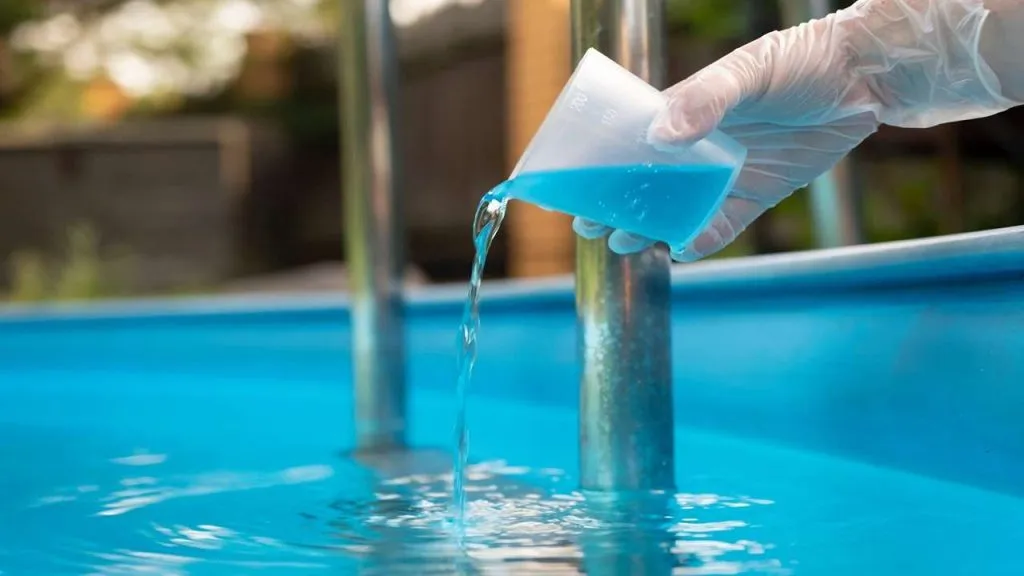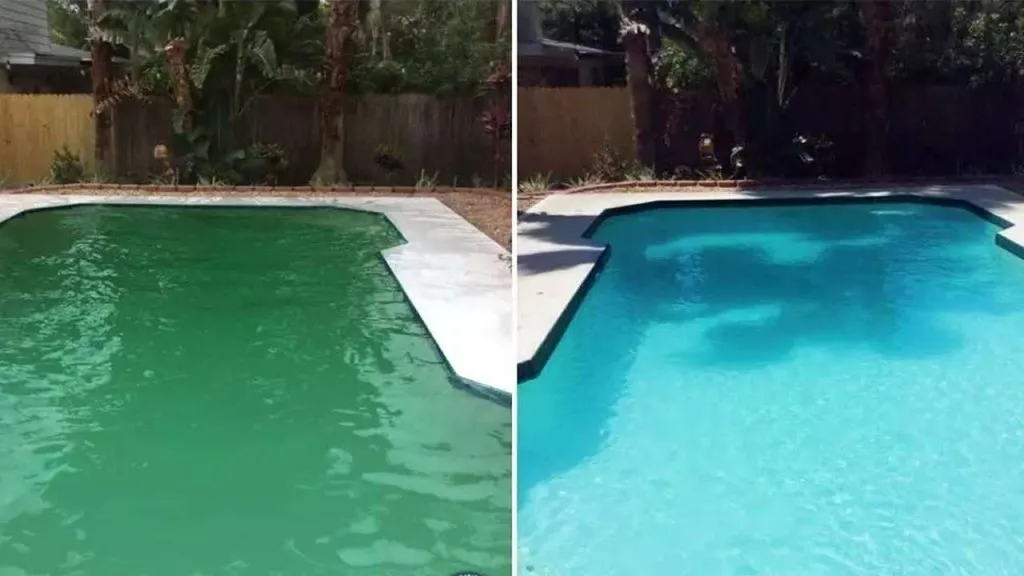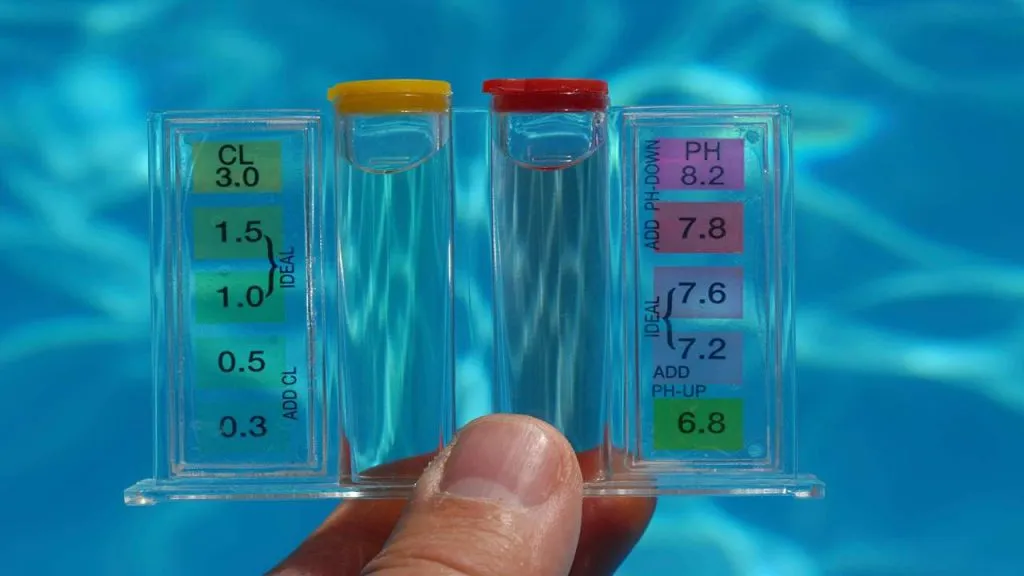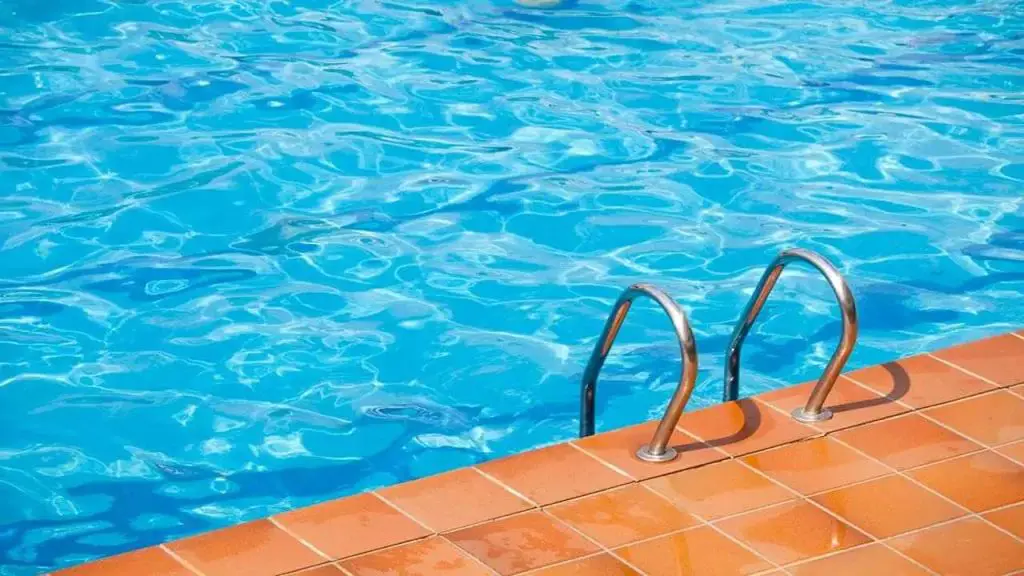As an Amazon Associate I earn from qualifying purchases.
It’s a common assumption that the salt chlorinator takes care of everything in salt water pools. Algae can still creep into the pool, making the water cloudy, and leave slick green pool patches along the walls.
Algaecide is an essential part of salt water pool care. If used correctly, it helps prevent stubborn algae blooms from taking hold and keeps your pool looking (and feeling) clean. However, not all pool treatment products work the same, especially in salt systems. And that’s where things get confusing.
In this guide, we’ll walk through how algaecide for salt water pool works, how to choose the right one, and how to make it part of a smart, low-maintenance routine that works for all pool owners to have a perfect pool experience.
Understanding Algaecide for Salt Water Pool

Algaecide is a chemical treatment designed for algae prevention in salt water pools. It’s not meant to replace chlorine or your salt system. It acts like backup support, stepping in when conditions get tough or your regular sanitizing levels dip for any reason.
Here’s a quick breakdown of how salt water pools differ from traditional chlorine pools:
| Feature | Salt Water Pools | Traditional Chlorine Pools |
| Chlorine Source | Generated from salt via electrolysis | Added manually (tablets, liquid, powder) |
| Feel on Skin & Eyes | Softer, less irritating | Can be harsh or drying |
| Maintenance Approach | Requires monitoring salt level & generator | Requires frequent chlorine additions |
| Cost Over Time | Higher upfront cost, lower chemical costs | Lower setup cost, ongoing chlorine expenses |
| Equipment Sensitivity | Salt can corrode some metals over time | Less risk of corrosion from salt |
Algae can still grow in salt water pools if your sanitizer levels drop too low, your pH gets out of whack, or debris is left floating around. That’s why preventing algae in pools is just as important as in any other system.
Once algae shows up, it doesn’t just go away by itself. It spreads fast, clogs filters, makes surfaces slippery, and turns your water from clear to cloudy in no time.
Regular use of an algaecide for salt water pools helps stop that cycle before it even starts. Now we know Algaecides are important, but what’s best for you? Let’s learn in the next section.
Choosing the Right Algaecide Products
Not every types of algaecide is made for saltwater systems; using the wrong one can do more harm than good.
The goal is to find products that work with your salt chlorinator, not against it.
A. HTH Specialized Chemicals for Salt Water Pools
If you’re looking for trusted, pool-store-quality products, HTH has a solid lineup made specifically for saltwater pool care.
Their salt-specific algaecide is non-foaming, won’t cloud your water, and is designed to be gentle on your salt cell.
Their formulas avoid heavy metals like copper, which can damage salt chlorinators over time. They’re also widely available and pretty beginner-friendly in dosage and instructions.
B. Popular Algaecide Options on Amazon
If you prefer to shop online, here are some top-rated type of algaecides compatible with salt water pools:
- Clorox® Pool&Spa™ Swimming Pool Algaecide: A non-foaming formula that effectively eliminates algae growth, offering lasting protection for your pool. Suitable for all pools, including saltwater pools.
- EasyCare PoolTec Algaecide: A combination of algaecide, clarifier, and chlorine salt cell booster in one, designed to enhance pool chlorine performance and keep water crystal clear.
- Pool RX 101001 Algaecide Unit: A powerful pool algaecide that comes with a capacity of treating 7.5k-20k gallons, releasing minerals that continuously eliminate various type of algae. A favourite among users for its ease of use and effectiveness.
- Swim Pool Algaecide 60 Plus: A highly concentrated, non-foaming algaecide that’s effective against a wide range of algae types. Known and appreciated for its quick action and value for money.
C. Key Features to Look For in Salt Water Pool Algaecides
Before clicking “Add to Cart,” keep an eye out for these features:
- Non-metallic pool algaecide formulas – No copper or silver, which can corrode equipment or stain surfaces
- Low-foam or non-foaming – Especially important if you use your pool right after treating
- Safe for salt chlorinators – Check the label or product description
- Broad-spectrum effectiveness – Targets multiple types of algae blooms: green algae, yellow algae, and black algae
- UV-resistant – Helps the formula hold up under direct sunlight
Now that you’ve got the right algaecide, here’s how to use it effectively.
Effective Application of Algaecide

Applying algaecide correctly ensures it does its job without wasting product or harming your pool.
A. Recommended Frequency of Application
For most salt water pools, algaecide isn’t to be used only after a bloom. It’s part of a salt pool maintenance routine.
- Preventative use: Once a week, especially in warmer months
- After heavy rain or high usage: Add a maintenance dose to stay ahead of any potential growth of algae
- Post-treatment: If you’ve just treated algae, reapply 3–5 days later to make sure it doesn’t return
A regular schedule helps prevent various types of pool algae in saltwater pools and supports your salt chlorinator.
B. Proper Dosage and Concentration
Always follow the manufacturer’s label, but here’s a general idea of what’s common for salt pool algae treatment plan:
| Pool Size (Gallons) | Maintenance Dose | Treatment Dose (Visible Algae) |
| 10,000 | 4–6 oz | 12–16 oz |
| 20,000 | 8–10 oz | 20–32 oz |
| 30,000+ | 12–14 oz | 32–48 oz |
Tip: If your water is cloudy or green, always shock the pool first, wait 24 hours, then add algaecideC. Safety Precautions During Use
Even if the product is salt-friendly, you still want to handle it with care:
- Wear gloves and avoid direct contact with skin or eyes
- Never mix algaecide with shock or other chemicals, as it can cause dangerous reactions
- Keep your pool pump running during and after application to circulate the treatment
- Store it somewhere cool and dry, away from direct sunlight and kids
Using the best algaecide for saltwater swimming pools is only half the battle. Using it safely and regularly is the key to keeping crystal-clear water without any headaches.
Maintaining Optimal Pool Chemistry

Even the best algaecide won’t work if your pool chemistry is out of balance. When pH, alkalinity, or sanitizer levels drift too far off, algae buildup get the upper hand.
A. Balancing pH, Alkalinity, and Sanitizer Levels
For saltwater pool chemistry to stay stable, here’s the ideal range to aim for:
| Parameter | Ideal Range | Why It Matters |
| pH | 7.4 – 7.6 | Too high or too low pH can make chlorine less effective |
| Alkalinity | 80 – 120 ppm | Acts as a buffer to keep pH from swinging wildly |
| Chlorine levels | 1 – 3 ppm (via salt cell) | Keeps algae, bacteria, and other contaminants in check |
Keep these balanced, and you’ll make your algaecide way more effective.
B. Regular Water Testing Procedures
Testing your swimming pool water is a part of smart salt water maintenance. Here’s how to stay on top of it:
- Test 2–3 times a week during peak swim season
- Use test strips or a liquid testing kit for better accuracy
- Consider a digital pool tester or a mobile app for tracking trends over time
- Test after rain, heavy usage, or anytime the water looks off
Regular testing helps catch issues early and maintain a balanced saltwater pool chemistry.
C. Complementary Chemical Treatments
To support both your chlorine and algaecide, a few other products can help:
- Stabilizer (CYA): Helps retain chlorine levels by protecting it from sunlight
- Calcium hardness increaser: Prevents corrosion of pool surfaces and equipment
- Enzymes or clarifiers: Help break down organics that feed algae
- Salt cell cleaner: Keeps your chlorinator functioning properly
Equipped with everything you need, let’s create a comprehensive salt water pool maintenance routine.
Comprehensive Pool Maintenance Routine
Algaecide is not enough for an algae-free, clean pool; you will have to follow a weekly routine, and here’s a simple one:
A. Weekly Cleaning Tasks (Skimming, Brushing, Vacuuming)
Skipping the basics is one of the fastest ways to invite algae. Here’s what your weekly checklist should include:
- Skim daily if you can. Leaves, bugs, and debris look bad and throw off your pool chemistry.
- Brush the walls and steps at least once a week. Algae love to cling to textured surfaces, especially in shady spots.
- Vacuum regularly (manually or with an automatic cleaner) to remove anything your filter doesn’t catch.
The cleaner your pool stays, the harder it is for algae to take hold in the first place.
B. Importance of Consistent Algaecide Treatment
Consistency turns a good pool into a great one. Adding algaecide weekly, as part of your salt pool maintenance routine, keeps things under control, especially during hot weather or high-use months.
Even if your pool looks crystal clear, don’t skip it. Algaecide works best as a preventative.
C. Utilizing Pool Care Apps for Expert Water Analysis & Guidance
Not sure when to test or what to add? Pool care apps make it simple. They let you:
- Log test results
- Get custom treatment suggestions
- Track swimming pool chemical usage
- Set reminders for filter cleaning, shocking, or algaecide applications
Using a pool app helps you stay one step ahead of algae season without doing any guesswork.
Benefits of Regular Algaecide Use

Adding algaecide to your routine plays a bigger role than just avoiding green water; it keeps your system running smoothly while saving time.
A. Prevention of Cloudy Water and Algae Growth
It doesn’t always show up as big green algae patches. Sometimes, the first sign is hazy or cloudy water. Regular algaecide use helps prevent that rapid growth buildup before it becomes a problem.
By keeping algae spores from multiplying, you reduce the chance of blooms that cloud your pool and clog up your filter.
B. Reduced Overall Maintenance Time and Effort
The more proactive you are with algaecide, the less you’ll have to deal with emergency cleanups, chemical rebalancing, or filter issues. It’s like brushing your teeth, you don’t wait for cavities to show up first.
In the long run, consistent use saves you hours of scrubbing, vacuuming, and re-treating. Less work, better water clarity.
C. Enhanced Swimming Experience and Pool Enjoyment
Nobody wants to swim in water with algae lurking in the corners. Keeping your water clean, balanced, and algae-free means you and anyone using your pool can actually enjoy it.
No smells, no slimy water surfaces, no cloudy water, just a clear, fresh swim every time.
Conclusion
Algae’s no match for a well-kept salt water pool. Use the right algaecide, keep your water chemistry balanced, and stick to an easy weekly routine to stop issues before they pop up. That way, you’ll have more time to kick back and enjoy a hygienic swimming experience.
Remember: Consistency is key. Treating your pool regularly and staying ahead of changes in weather or usage will keep things running smoothly all season long.
Amazon and the Amazon logo are trademarks of Amazon.com, Inc, or its affiliates
